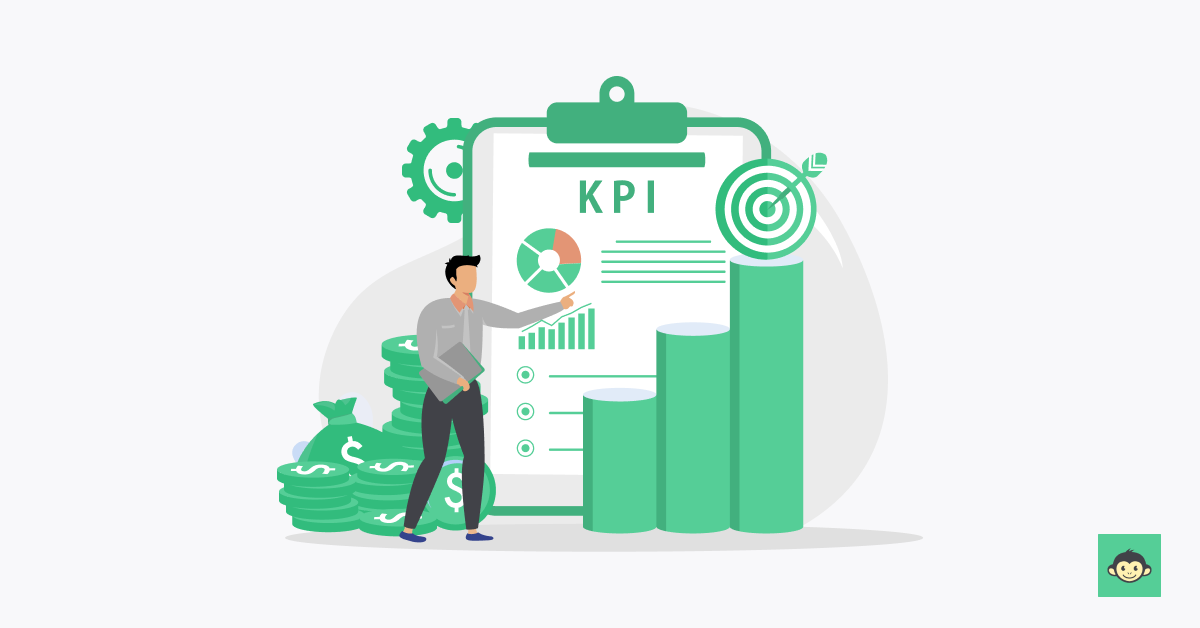What is employee engagement KPI: Tips to measure and improve it in 2023

A study by Deloitte found that companies with highly engaged employees outperform their peers by 147% in earnings per share. This statistic underscores the financial impact of employee engagement and the potential for organizations to gain a competitive edge by investing in this area.
As we venture through the year 2023, it is crucial for organizations to stay at the forefront of employee engagement practices by leveraging the latest tools and strategies.
Let's explore the key tips and strategies for effectively measuring and improving employee engagement KPIs in 2023.
Table of contents:-
- What is a KPI for employee engagement?
- What are employee engagement KPI metrics?
- How does the employee engagement KPI calculation work?
- The need for measuring employee engagement KPI
- 17 Employee engagement KPIs that are a must-track to measure engagement
- How can tracking employee engagement KPIs improve retention?
- How can an employee engagement platform help you measure and improve employee engagement KPI?
- FAQs
What is a KPI for employee engagement?

A Key Performance Indicator (KPI) for employee engagement is a measurable metric used to evaluate and track the level of engagement within an organization. While several KPIs can be used, one common example is the employee engagement score, which is typically derived from employee surveys or assessments.
This score quantifies the overall level of engagement based on factors such as job satisfaction, commitment, motivation, and alignment with the organization's goals. Other KPIs may include turnover rate, absenteeism, productivity levels, and employee satisfaction ratings.
These KPIs provide insights into the effectiveness of employee engagement initiatives and help organizations identify areas for improvement to create a more engaged workforce.
What are employee engagement KPI metrics?

Employee engagement KPI metrics are specific measures used to assess the level of engagement within an organization. These metrics provide valuable insights into the effectiveness of employee engagement initiatives and help identify areas for improvement.
Common employee engagement KPI metrics include -
Employee engagement score
Employee engagement score measures the number of employees and overall level of engagement within the organization. It is typically derived from employee surveys or assessments that gauge factors such as job satisfaction, commitment, motivation, and alignment with the organization's goals.
Turnover rate
High turnover can indicate a lack of employee engagement in company culture. Tracking the percentage of employees who leave the organization within a specific period can provide insights into the effectiveness of engagement initiatives.
Absenteeism
Excessive absenteeism can be a sign of low employee engagement. Monitoring the frequency and duration of employee absences can help business leaders identify any underlying issues related to engagement.
Productivity levels
Engaged employees tend to be more productive. Tracking productivity metrics, such as output per employee or sales performance per engaged employee, can indicate the impact of engagement on overall organizational productivity.
Employee satisfaction ratings
Regular employee satisfaction surveys or feedback mechanisms can provide valuable insights into engagement levels. Analyzing employee satisfaction index and ratings in areas such as leadership, communication, work-life balance, and career development can help identify areas for improvement.
Participation in employee programs
Monitoring employee participation in programs and initiatives, such as training sessions, employee resource groups, or wellness activities, can indicate the level of engagement and employee involvement within the organization.
Performance evaluation ratings
Assessing employee engagement surveys' performance evaluation ratings can provide insights into the relationship between engagement and individual performance. Higher ratings may indicate a positive correlation between engagement and performance.
Peer recognition and collaboration
Metrics related to peer recognition and collaboration, such as the total number of employees, employee-to-employee recognition instances, or cross-functional team participation, can indicate the level of engagement and teamwork within the organization.
By tracking these employee engagement KPI metrics, organizations can gain a deeper understanding of their engagement levels and identify areas for improvement. It is important to regularly review and analyze these metrics to make data-driven decisions, implement targeted strategies, and continuously enhance employee engagement within the organization.
Employee net promoter score (eNPS)
Employee net promoter score measures the likelihood of employees recommending the organization as a place to work. It is based on a survey question asking employees how likely they are to refer others to join the company. A high eNPS indicates positive employee sentiment and engagement, and employees feel more satisfied with their work experience.
These employee engagement KPIs provide organizations with quantifiable measures to assess the level of engagement within their workforce. By regularly monitoring and analyzing these KPIs, organizations can identify trends, implement targeted interventions, and track progress in improving employee engagement, ultimately, employee well-being and leading to a more motivated, productive, and satisfied workforce.
How does the employee engagement KPI calculation work?

Employee engagement Key Performance Indicators (KPIs) are quantitative measures used to assess and evaluate the level of employee engagement within an organization. These KPIs help companies gauge the effectiveness of their efforts to create a positive and productive work environment.
While the specific KPIs and their calculations may vary across organizations, we can provide a general overview of how the employee engagement KPI calculation works:
- Determine the employee engagement metrics: The first step in calculating employee engagement KPIs is to identify the specific metrics that will be used to measure engagement. These metrics can include factors such as employee satisfaction, commitment, motivation, loyalty, and productivity. It's essential to select metrics that align with the organization's goals and objectives.
- Collect data: Once the employee engagement metrics are established, data needs to be collected. This data can be obtained through various methods, including surveys, feedback forms, focus groups, interviews, or existing HR data. It's important to ensure that the data collection process is anonymous, confidential, and designed to gather honest and unbiased responses.
- Assign weightage: After collecting the data, assign weightage to each metric based on its relative importance to the organization's goals. This step involves determining the significance of each metric and its contribution to overall employee engagement. For example, employee satisfaction may be given a higher weightage compared to other metrics.
- Calculate scores: Once the weightage is assigned, calculate individual scores for each metric. This can be done by assigning numerical values or ratings to responses based on predefined scales. For instance, a Likert scale can be used to assign scores ranging from 1 to 5, representing different levels of engagement or satisfaction.
- Aggregate scores: After calculating individual scores for each metric, aggregate the scores to derive an overall employee engagement score. This can be done by summing up the scores for all metrics or by applying a weighted average based on the assigned weightage.
- Benchmarking and analysis: Once the employee engagement score is determined, it's crucial to compare it against industry benchmarks or previous internal measurements. Benchmarking allows organizations to understand how they fare in relation to their competitors or past performance. Furthermore, conducting a detailed analysis of the results can help identify areas of strength and areas that need improvement.
- Set actionable goals: Based on the analysis of the employee engagement KPIs, organizations can identify actionable goals to enhance employee engagement. These goals can be focused on areas where improvement is needed, such as implementing training programs, enhancing communication channels, or recognizing and rewarding employee achievements.
- Track progress: To monitor progress and measure the effectiveness of the initiatives taken to improve employee engagement, it's important to track the employee engagement KPIs regularly. This helps organizations identify trends, patterns, and the impact of their interventions over time.
It's important to note that the specific calculation methods and KPIs may vary across organizations based on their unique requirements and goals. The key is to ensure that the KPIs selected align with the organization's objectives and provide meaningful insights into employee engagement levels.
The need for measuring employee engagement KPI

Measuring employee engagement Key Performance Indicators (KPIs) are essential for organizations for several reasons. The need for measuring employee engagement KPIs arises from the recognition that engaged and satisfied employees are crucial for a company's success.
Here are the reasons why measuring employee engagement KPIs is important:
Assessing organizational health: Employee engagement KPIs provide insights into an organization's overall health and well-being. By measuring engagement levels, organizations can gauge the extent to which employees are emotionally invested, motivated, and satisfied with their work.
This information helps identify areas of improvement and potential issues that may affect productivity and performance.
Identifying strengths and weaknesses: Measuring employee engagement KPIs allows organizations to identify their strengths and weaknesses regarding employee engagement. By understanding what aspects of the work environment contribute to high engagement levels, organizations can reinforce those practices and build upon them.
Additionally, identifying areas of weakness enables organizations to address and improve upon factors that may be hindering employee engagement.
Enhancing retention and talent management: Engaged employees are likely to stay with an organization, reducing turnover rates and associated costs. Measuring employee engagement KPIs helps identify factors that contribute to employee satisfaction and commitment, allowing organizations to implement strategies to retain top talent.
This can include initiatives such as career development programs, work-life balance initiatives, and recognition programs.
Boosting productivity and performance: Engaged employees tend to be more productive, innovative, and committed to achieving organizational goals. Measuring employee engagement KPIs helps organizations assess the impact of engagement on productivity and performance levels.
By identifying areas where engagement is lacking, organizations can implement strategies to enhance motivation, collaboration, and job satisfaction, leading to improved performance and outcomes.
Enhancing employee experience: Measuring employee engagement KPIs is crucial for understanding the employee experience within an organization. It provides valuable insights into the factors that influence employee satisfaction, motivation, and well-being.
With this information, organizations can create a positive work environment, align their practices with employee expectations, and foster a culture that supports employee growth and development.
Driving continuous improvement: Measuring employee engagement KPIs enables organizations to track progress over time. By establishing a baseline and regularly monitoring engagement levels, organizations can assess the impact of interventions and initiatives aimed at improving employee engagement.
This data-driven approach helps identify trends, measure the effectiveness of strategies, and make informed decisions for continuous improvement.
Measuring employee engagement KPIs is crucial for organizations to assess their overall health, identify areas of improvement, enhance retention and talent management, boost employee morale, productivity, and performance, enhance the employee experience, and drive continuous improvement.
By understanding and measuring engagement levels, organizations can develop targeted strategies to create a positive and engaging work environment that supports the success and well-being of their employees.
17 Employee engagement KPIs that are a must-track to measure engagement

Measuring employee engagement is crucial for organizations to understand and improve the level of employee satisfaction, motivation, and commitment.
While specific Key Performance Indicators (KPIs) may vary based on the organization's goals and industry, here are 17 commonly tracked employee engagement KPIs:
- Employee satisfaction score (ESS): A metric that assesses overall satisfaction levels through employee surveys or feedback.
- Employee net promoter score (eNPS): eNPS measures the likelihood of employees recommending the organization as a place to work.
- Employee turnover rate: Calculates the percentage of employees who leave the organization over a given period.
- Absenteeism rate: Measures the rate of employee absences, which can indicate disengagement or dissatisfaction.
- Employee tenure: Tracks the average length of time employees stay with the organization, indicating loyalty and engagement.
- Employee referral rate: Measures the number of new hires that come through employee referrals, showing engagement and advocacy.
- Employee productivity: Assesses individual or team productivity levels, indicating the impact of engagement on performance.
- Employee performance ratings: Measures individual or team performance, reflecting engagement and motivation levels.
- Employee recognition rate: Tracks the frequency and effectiveness of employee recognition programs or initiatives.
- Employee development opportunities: Measures the availability and utilization of training and development programs.
- Employee feedback participation: Measures the rate of employee participation in providing feedback or suggestions.
- Manager-employee relationship: Assesses the quality of relationships between employees and their managers through surveys or 360-degree feedback.
- Employee empowerment: Measures the level of autonomy and decision-making authority employees have in their roles.
- Diversity and inclusion metrics: DEI tracks the organization's efforts and progress in fostering a diverse and inclusive work environment.
- Employee wellness: Measures the engagement with and impact of wellness programs on employees' physical and mental well-being.
- Employee engagement survey participation: Tracks the rate of employee participation in engagement surveys.
- Internal mobility rate: Measures the frequency of internal promotions or transfers, indicating opportunities for growth and engagement.
These KPIs provide organizations with valuable insights into different facets of employee engagement and positive company culture. It's important to choose KPIs that align with the organization's specific goals, industry, and culture.
Regularly tracking and analyzing these metrics can help organizations identify areas of improvement, measure the effectiveness of engagement initiatives, and foster a positive and productive work environment.
How can tracking employee engagement KPIs improve retention?

Tracking employee engagement Key Performance Indicators (KPIs) that measure employee engagement can play a significant role in improving employee retention within an organization.
Here are several ways in which tracking employee engagement KPIs can help enhance retention:
Identifying engagement levels: By tracking employee engagement KPIs, organizations can gain insights into the overall level of engagement among their workforce. This data helps identify areas where engagement may be low, allowing organizations to take proactive measures to address these issues before they lead to employee dissatisfaction and turnover.
Addressing disengagement factors: Employee engagement KPIs provide information about the factors that contribute to disengagement. By analyzing the data, organizations can identify specific areas where employees may be experiencing challenges or frustrations.
With this knowledge, they can implement targeted initiatives to address these factors and create a more engaging work environment.
Improving communication and feedback: Employee engagement KPIs often include metrics related to communication and feedback. Tracking these KPIs can highlight gaps or weaknesses in the organization's communication channels and feedback mechanisms.
By addressing these issues and ensuring effective communication and feedback processes, organizations can enhance employee satisfaction, engagement, and ultimately retention.
Enhancing employee development opportunities: Employee engagement KPIs related to training, development, and growth opportunities can provide insights into employees' perceptions of their career progression within the organization.
By tracking these metrics, organizations can identify areas where employees may feel stagnant or lacking growth opportunities. By offering targeted development programs, promotions, or internal mobility opportunities, organizations can improve retention by providing employees with a clear path to advancement.
- Recognizing and rewarding employee contributions: Tracking employee engagement KPIs related to recognition and rewards can help organizations identify areas where employees may feel undervalued or underappreciated. By implementing effective recognition and reward programs based on these insights, organizations can create a culture of appreciation and increase employee satisfaction, leading to improved retention rates.
- Enhancing leadership and managerial effectiveness: Employee engagement KPIs often include metrics related to employee-manager relationships. By tracking these metrics, organizations can identify managers who may need additional support or training in effectively engaging and motivating their teams. By improving leadership and managerial effectiveness, organizations can create a positive work environment that fosters employee engagement and reduces turnover.
- Monitoring the impact of interventions: Tracking employee engagement KPIs allows organizations to measure the effectiveness of initiatives implemented to improve engagement. By analyzing the data, organizations can determine which interventions are driving positive changes in engagement levels and retention. This information helps organizations refine their strategies and invest resources in initiatives that yield the highest impact on employee retention.
Tracking employee engagement KPIs provides organizations with valuable data to identify areas of improvement, address disengagement factors, enhance communication and feedback, improve development opportunities, recognize employee contributions, enhance leadership effectiveness, and monitor the impact of interventions.
By actively monitoring and acting upon these KPIs, organizations can create a more engaging work environment, increase overall employee satisfaction, and ultimately improve retention rates.
How can an employee engagement platform help you measure and improve employee engagement KPI?

An employee engagement platform like CultureMonkey can be a valuable tool in measuring and improving employee engagement KPIs. Here's how such a platform can assist in this process:
Centralized data collection: An engagement platform allows organizations to gather employee feedback and data in a centralized manner. It provides a streamlined process for collecting information through surveys, pulse checks, and other feedback mechanisms. By consolidating data from various sources, the platform provides a comprehensive view of employee engagement, making it easier to measure and track relevant KPIs.
Real-time monitoring: An engagement platform enables real-time monitoring of employee engagement KPIs. Instead of relying on periodic surveys or manual data analysis, the platform provides up-to-date insights into engagement levels. This allows organizations to identify trends, track progress, and promptly address any emerging issues that may affect employee engagement.
Customizable KPI tracking: Employee engagement platforms typically offer customizable dashboards and reporting features. This allows organizations to define and track their specific employee engagement KPIs based on their goals and priorities. The platform can generate visualizations and reports that make it easy to measure and communicate KPI performance, facilitating data-driven decision-making.
Actionable insights: A robust engagement platform goes beyond data collection and reporting. It provides analytical capabilities that help uncover actionable insights from the collected data. The platform may offer sentiment analysis, text mining, and other techniques to identify patterns, themes, and underlying factors impacting employee engagement. These insights can guide organizations in formulating targeted strategies to improve engagement and address specific areas of concern.
Targeted interventions: An engagement platform can facilitate targeted interventions to improve employee engagement. Based on the insights gained from the platform's analytics, organizations can design and implement initiatives tailored to address identified gaps or challenges. The platform can assist in tracking the effectiveness of these interventions over time, allowing organizations to refine their approaches and optimize their impact on employee engagement KPIs.
Communication and collaboration: Many engagement platforms include features that foster communication and collaboration among employees. These features can enhance employee engagement by providing avenues for open dialogue, idea sharing, and cross-team collaboration. By facilitating effective communication, the platform contributes to a positive work environment and strengthens employee engagement.
Continuous improvement: An engagement platform supports a continuous improvement approach to employee engagement. By regularly measuring and monitoring engagement KPIs, organizations can establish a feedback loop that helps them iterate and refine their engagement strategies. The platform's features enable organizations to assess the impact of interventions, make data-driven adjustments, and sustain a culture of ongoing improvement.
In conclusion, an employee engagement platform streamlines data collection, offers real-time monitoring, customizable KPI tracking, actionable insights, targeted interventions, communication, and collaboration features, and supports a continuous improvement approach.
By leveraging these capabilities, organizations can effectively measure and improve their employee engagement KPIs, leading to a more engaged and productive workforce.
FAQs
What is employee engagement KPI, and why is it important in 2023?
Employee engagement KPI (Key Performance Indicator) refers to quantifiable metrics used to measure the level of employee engagement within an organization. It is important in 2023 because employee engagement plays a crucial role in driving productivity, reducing turnover, and enhancing overall organizational performance.
What are some common employee engagement KPIs to measure in 2023?
Common employee engagement KPIs in 2023 include Employee Satisfaction Score (ESS), Employee Net Promoter Score (eNPS), Employee Turnover Rate, Absenteeism Rate, Employee Productivity, Employee Performance Ratings, Employee Recognition Rate, and Employee Development Opportunities.
How can organizations measure employee engagement KPIs effectively in 2023?
To measure employee engagement KPIs effectively in 2023, organizations can leverage employee engagement platforms that centralize data collection, provide real-time monitoring, and offer customizable reporting features. These platforms enable organizations to gather feedback, analyze data, and track KPI performance.
What are some strategies to improve employee engagement KPIs in 2023?
To improve employee engagement KPIs in 2023, organizations can focus on enhancing communication and feedback channels, providing growth and development opportunities, implementing effective recognition and reward programs, fostering a positive work culture, promoting work-life balance, and nurturing strong manager-employee relationships.
How can technology support the measurement and improvement of employee engagement KPIs in 2023?
Technology plays a vital role in measuring and improving employee engagement KPIs in 2023. Employee engagement platforms provide tools for efficient data collection, analysis, and reporting. Advanced analytics and sentiment analysis techniques enable organizations to gain actionable insights from the collected data.



